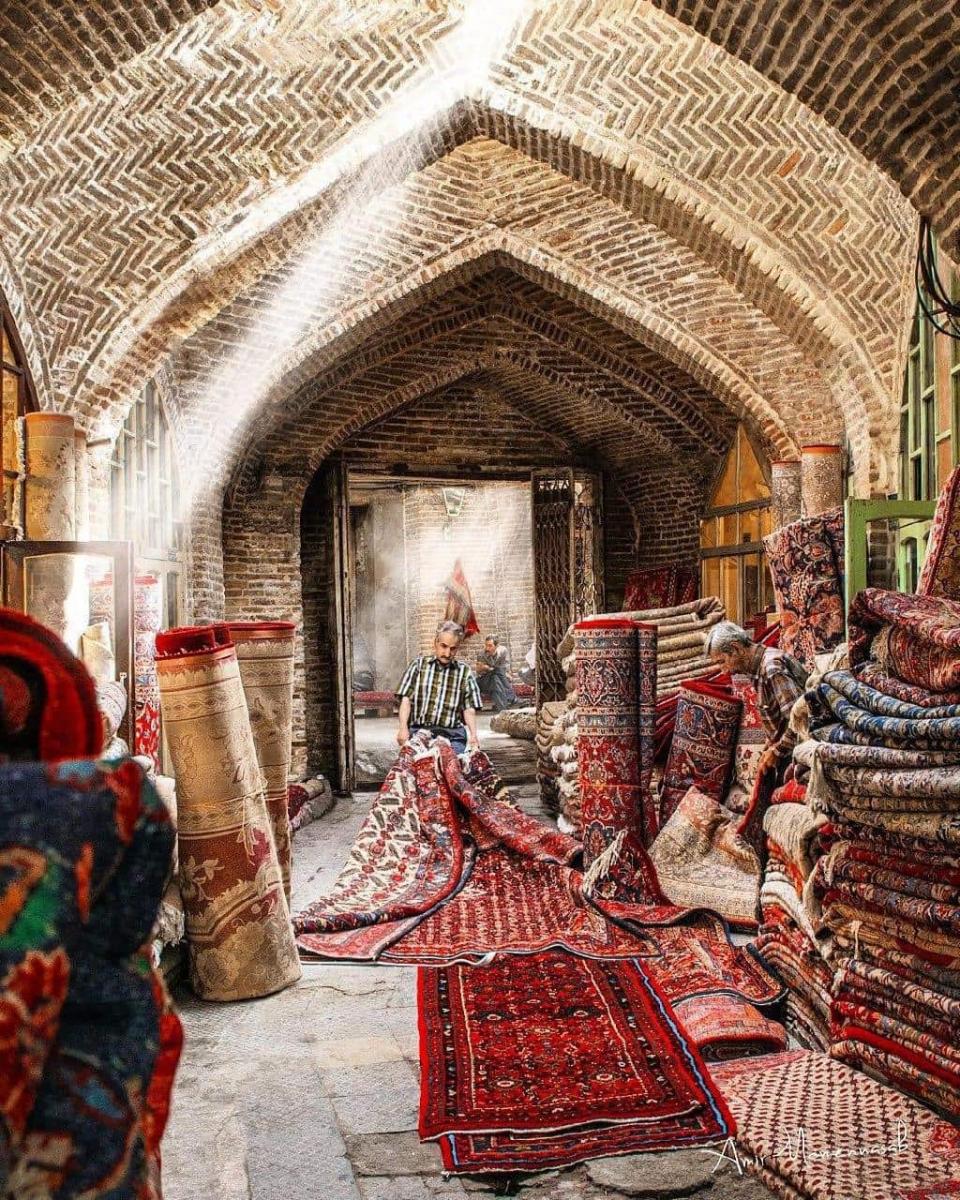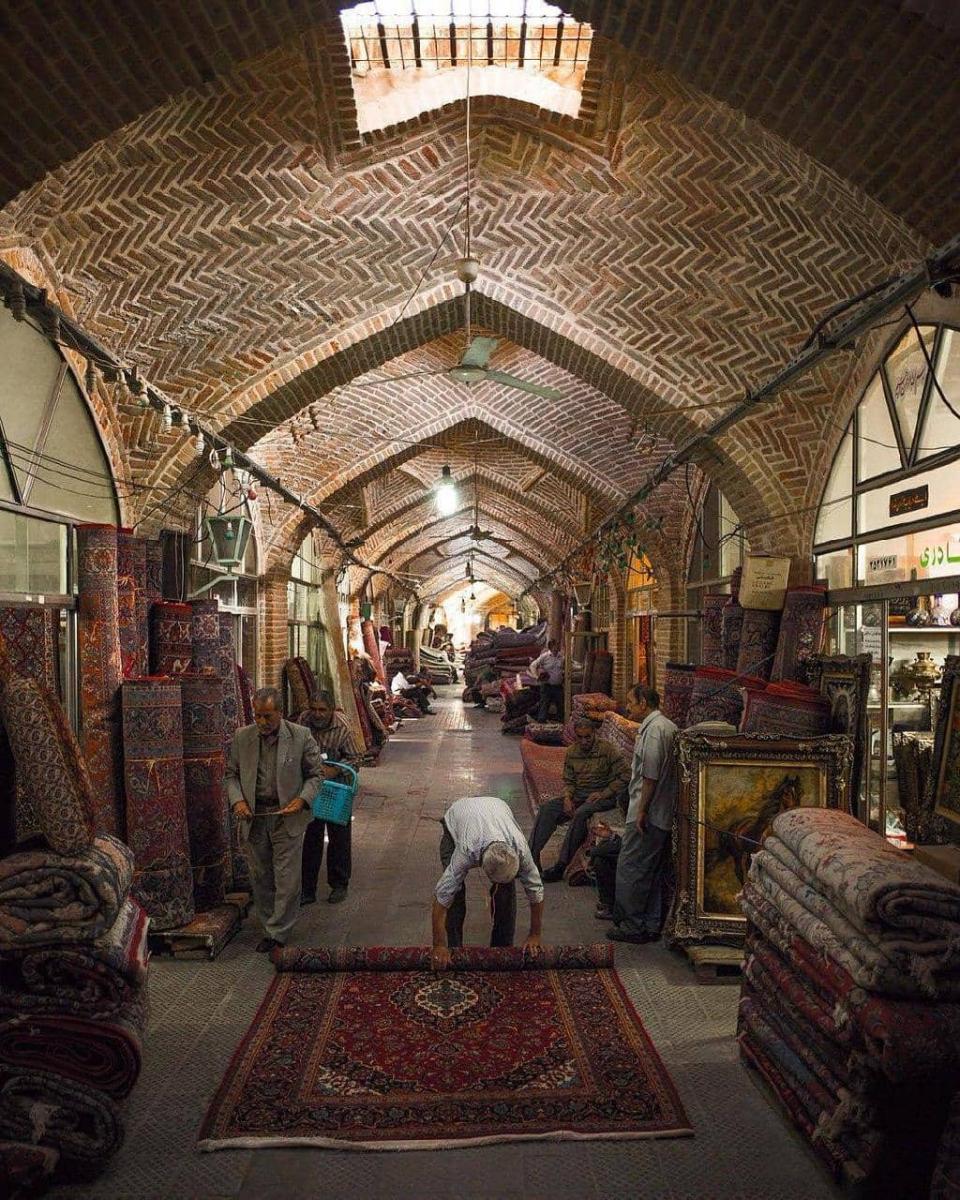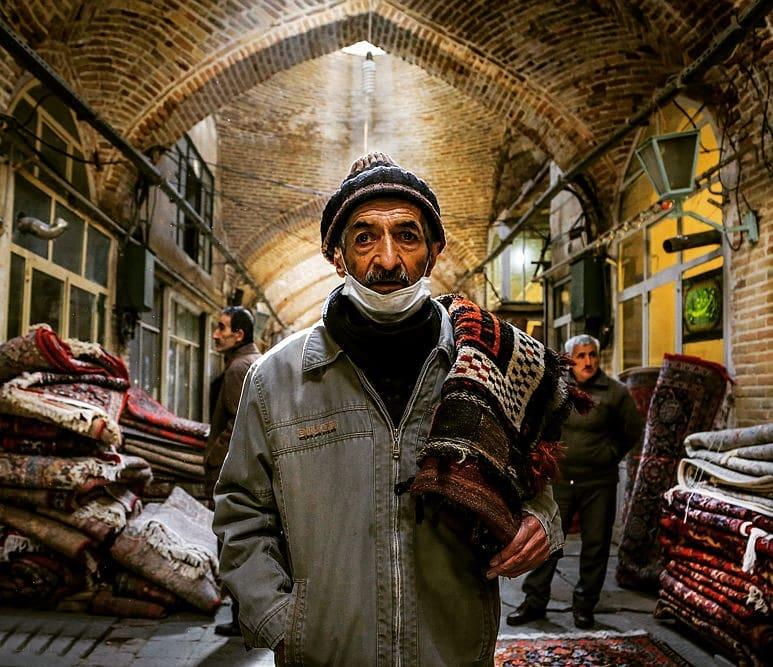Hamedan Traditional Bazaar old but gold!
Also known as
- Traditional Bazaar of Hamedan
- Hamedan Grand Bazaar
Geographical location of Hamedan Traditional Bazaar
It is located in the central square of Hamedan City, Hamedan Province, within three streets of Shohada, Ekbatan, and Babataher. It’s the most crowded and densely-populated parts of the city.
History and culture of Hamedan Traditional Bazaar
Bazaar has been one of the most influential pillars of cities’ social evolutions and political and economic developments in all periods. It was the bazaar that, as the most important urban joint, brought together the people from different neighborhoods and different races, and became a manifestation of unity and integrity of the people of the city.
Hamedan Bazaar has been of special economic and geographical importance due to its location on one of the main branches of the Silk Road, the communication routes of western cities, and religious places which attract a large number of pilgrims every year. It is mostly known as the country’s “Anbar” (literally: store), because of the many commercial stores in the area.
After the opening of railway lines within the capital and the northern and southern parts of the country, Hamedan lost its importance as a trade route. As a result, the Grand Bazaar of Hamedan lost its profitability and was torn down in some sectors. Fortunately, later on, it was restored and back to business again. The current structure is a remain from Qajar and Pahlavi dynasty located in the central core of the city. It consists of several rows, each of which is dedicated to a special type of product.
Some bazaars, such as caravanserais, consisted of various rooms on several floors, and were used as offices for warehouses and trading houses, and were owned by wealthy people, who gained a lot of money by renting or selling the rooms. The number of caravanserais in Hamedan Bazaar has reached 120 units, which is twice the number of caravanserais in Isfahan that was one of the capitals of the Safavid era.
Architecture of Hamedan Traditional Bazaar
The current complex of Hamedan Bazaar consists of 38 bazaars and 26 caravanserais, each of which has different entrances. The Bazaar’s main entrance is from the northern front of the Hamedan Jameh Mosque and continues up to a radius of 500 meters in north and northeast direction. Only some parts of the Bazaar such as confectioners, butchers, pea-roasters, tin-makers, book-binders, shoemakers, and dealers in second-hand goods, are roofed while other sections are wide open.
All the bazaars of Hamedan, like the traditional bazaar, were built around the axis of a Mosque, this is due to the necessity of having a mosque around the bazaar so that shopkeepers can go to and pray. This bazaar is made up of about 24 arcades that reveal its importance back in the days.
The various rows in the bazaar of Hamadan are the goldsmiths, Chest-makers, locksmiths, butchers, confectioners, bookbinders, glassware, tin-makers, haberdasheries, shoe-makers, rope-makers, including others called by the names of Felestin, Hossain Khani, Haj Fazlolah, Golshan, tanneries, etc. besides the alley to the Jameh Mosque.
The west side, which has 14 rooms, is specific to carpets. The first floor is dedicated to buying and selling and the second floor is dedicated to repairing and embroidering carpets. Its construction materials are brick, plaster, and lime, and its roof is in the form of pointed arches, and the valves are used to provide light and air. In front of it is the Mirza Kazem Caravanserai, whose merchants are also engaged in buying and selling carpets.
The height of each row varies depending on whether it is roofed or not; and depending on the type of roof covering. Therefore, rows without roofs have a height equal to the height of the surrounding chambers and buildings. Due to the cold climate of Hamedan, the roofs are made in the form of domes to trap energy.
Transportation of goods has always been done by wheelbarrows so every row is of small width and it only varies depending on the type of goods sold in that row. For example, in the carpet sellers’ row due to the need to spread the carpet in front of the chambers and also to transport the carpets by wheelbarrows, the width is more than five meters; unlike other rows that are not more than 2.5 to 5 meters. As a result, there’s no space for cars to pass so you can only walk through these old chambers and enjoy.
Tips and ideas
Thanks to the location of this old bazaar in the center of the city, all needed facilities are easily accessible. There are many traditional cafeterias, restaurants, hotels, and etc. nearby that you can take visit especially some handicraft shops that attract a lot of tourists every year.
The ancient Hegmataneh Hill is located in the north of Hamadan Bazaar. Stephen Gregory Church, which is the oldest church in Hamadan, is located on the eastern side of the bazaar. One of the largest Qajar caravanserais in Hamedan is located a few steps away from the bazaar and in the south. Mirza Kazem Caravanserai and Golshan Caravanserai are almost in front of each other, which you can visit after walking through the grand bazaar. If you are not tired of walking in the historical texture of Hamedan, the Hamedan’s Jameh Mosque can also be your next option for sightseeing in Hamedan. You can also use the map below to find all nearby monuments, restaurants, shops, and more.
IRANWHATCHING would love to read your personal experiences. Please share them with us in the comments below.
 2020-10-26 11:21:43+3:30
2021-11-09 09:56:42+3:30
Bazaar has been one of the most influential pillars of cities’ social evolutions and political and economic developments in all periods. It was the bazaar that, as the most important urban joint, brought together the people from different neighborhoods and different races, and became a manifestation of unity and integrity of the people of the city. Hamedan Bazaar has been of special economic and geographical importance due to its location on one of the main branches of the Silk Road, the communication routes of western cities, and religious places which attract a large number of pilgrims every year. It is mostly known as the country’s “Anbar” (literally: store), because of the many commercial stores in the area.
2020-10-26 11:21:43+3:30
2021-11-09 09:56:42+3:30
Bazaar has been one of the most influential pillars of cities’ social evolutions and political and economic developments in all periods. It was the bazaar that, as the most important urban joint, brought together the people from different neighborhoods and different races, and became a manifestation of unity and integrity of the people of the city. Hamedan Bazaar has been of special economic and geographical importance due to its location on one of the main branches of the Silk Road, the communication routes of western cities, and religious places which attract a large number of pilgrims every year. It is mostly known as the country’s “Anbar” (literally: store), because of the many commercial stores in the area.



 eyJpdiI6IkNZOXdKSy9USm5QL3JRYXBVWGVXSFE9PSIsInZhbHVlIjoiNnNHNElyT0czZEFuMGJLSUNlSHZ5QT09IiwibWFjIjoiMWYzY2Q4ZjM1ODYyNWM3YWNmMTIyMzE4YTNhNGY3NGYwZjU2MGUzYTQxYzVmY2ExNjVjMmE1ZDYzODZkZGY4MiIsInRhZyI6IiJ9 eyJpdiI6ImNSSW5pZ0I5VHlJc3A3U09VWFRZTWc9PSIsInZhbHVlIjoiM05NMUZtV0NQenFsOHFNWFRKUTJ0QT09IiwibWFjIjoiZTllZGE4NjhiY2YzNjEzYTI1MmIyY2RkZjEyNzI5NjdiZGQ3YzEzOTY5ZDk2NDZkZWZjNzk4YzI2N2M0MzdkNyIsInRhZyI6IiJ9
Author
info@yaldamedtour.com
/en/user-profile/10233
YaldaMedTour
Barajin Salamat Road
+98
Qazvin
Qazvin, Qazvin Province, Iran.
,
info@yaldamedtour.com
Hamedan Traditional Bazaar - old but gold!
Hamedan Traditional Bazaar - old but gold!
eyJpdiI6IkNZOXdKSy9USm5QL3JRYXBVWGVXSFE9PSIsInZhbHVlIjoiNnNHNElyT0czZEFuMGJLSUNlSHZ5QT09IiwibWFjIjoiMWYzY2Q4ZjM1ODYyNWM3YWNmMTIyMzE4YTNhNGY3NGYwZjU2MGUzYTQxYzVmY2ExNjVjMmE1ZDYzODZkZGY4MiIsInRhZyI6IiJ9 eyJpdiI6ImNSSW5pZ0I5VHlJc3A3U09VWFRZTWc9PSIsInZhbHVlIjoiM05NMUZtV0NQenFsOHFNWFRKUTJ0QT09IiwibWFjIjoiZTllZGE4NjhiY2YzNjEzYTI1MmIyY2RkZjEyNzI5NjdiZGQ3YzEzOTY5ZDk2NDZkZWZjNzk4YzI2N2M0MzdkNyIsInRhZyI6IiJ9
Author
info@yaldamedtour.com
/en/user-profile/10233
YaldaMedTour
Barajin Salamat Road
+98
Qazvin
Qazvin, Qazvin Province, Iran.
,
info@yaldamedtour.com
Hamedan Traditional Bazaar - old but gold!
Hamedan Traditional Bazaar - old but gold!
 Bazaar has been one of the most influential pillars of cities’ social evolutions and political and economic developments in all periods. It was the bazaar that, as the most important urban joint, brought together the people from different neighborhoods and different races, and became a manifestation of unity and integrity of the people of the city. Hamedan Bazaar has been of special economic and geographical importance due to its location on one of the main branches of the Silk Road, the communication routes of western cities, and religious places which attract a large number of pilgrims every year. It is mostly known as the country’s “Anbar” (literally: store), because of the many commercial stores in the area.
Bazaar has been one of the most influential pillars of cities’ social evolutions and political and economic developments in all periods. It was the bazaar that, as the most important urban joint, brought together the people from different neighborhoods and different races, and became a manifestation of unity and integrity of the people of the city. Hamedan Bazaar has been of special economic and geographical importance due to its location on one of the main branches of the Silk Road, the communication routes of western cities, and religious places which attract a large number of pilgrims every year. It is mostly known as the country’s “Anbar” (literally: store), because of the many commercial stores in the area.



 North of Imam Khomeini Square, Hamedan, Hamedan Province, Iran.
+98
North of Imam Khomeini Square, Hamedan, Hamedan Province, Iran.
North of Imam Khomeini Square, Hamedan, Hamedan Province, Iran.
IR
Show On Google Maps
Hamedan Traditional Bazaar - old but gold!
Hamedan Traditional Bazaar - old but gold!
North of Imam Khomeini Square, Hamedan, Hamedan Province, Iran.
+98
North of Imam Khomeini Square, Hamedan, Hamedan Province, Iran.
North of Imam Khomeini Square, Hamedan, Hamedan Province, Iran.
IR
Show On Google Maps
Hamedan Traditional Bazaar - old but gold!
Hamedan Traditional Bazaar - old but gold!
 Bazaar has been one of the most influential pillars of cities’ social evolutions and political and economic developments in all periods. It was the bazaar that, as the most important urban joint, brought together the people from different neighborhoods and different races, and became a manifestation of unity and integrity of the people of the city. Hamedan Bazaar has been of special economic and geographical importance due to its location on one of the main branches of the Silk Road, the communication routes of western cities, and religious places which attract a large number of pilgrims every year. It is mostly known as the country’s “Anbar” (literally: store), because of the many commercial stores in the area.
North of Imam Khomeini Square, Hamedan, Hamedan Province, Iran.
+98
North of Imam Khomeini Square, Hamedan, Hamedan Province, Iran.
North of Imam Khomeini Square, Hamedan, Hamedan Province, Iran.
IR
Show On Google Maps
Adults
Persian
English.
Bazaar has been one of the most influential pillars of cities’ social evolutions and political and economic developments in all periods. It was the bazaar that, as the most important urban joint, brought together the people from different neighborhoods and different races, and became a manifestation of unity and integrity of the people of the city. Hamedan Bazaar has been of special economic and geographical importance due to its location on one of the main branches of the Silk Road, the communication routes of western cities, and religious places which attract a large number of pilgrims every year. It is mostly known as the country’s “Anbar” (literally: store), because of the many commercial stores in the area.
North of Imam Khomeini Square, Hamedan, Hamedan Province, Iran.
+98
North of Imam Khomeini Square, Hamedan, Hamedan Province, Iran.
North of Imam Khomeini Square, Hamedan, Hamedan Province, Iran.
IR
Show On Google Maps
Adults
Persian
English.
Hamedan Traditional Bazaar - old but gold!
 Bazaar has been one of the most influential pillars of cities’ social evolutions and political and economic developments in all periods. It was the bazaar that, as the most important urban joint, brought together the people from different neighborhoods and different races, and became a manifestation of unity and integrity of the people of the city. Hamedan Bazaar has been of special economic and geographical importance due to its location on one of the main branches of the Silk Road, the communication routes of western cities, and religious places which attract a large number of pilgrims every year. It is mostly known as the country’s “Anbar” (literally: store), because of the many commercial stores in the area.
North of Imam Khomeini Square, Hamedan, Hamedan Province, Iran.
+98
North of Imam Khomeini Square, Hamedan, Hamedan Province, Iran.
North of Imam Khomeini Square, Hamedan, Hamedan Province, Iran.
IR
unknown
Bazaar has been one of the most influential pillars of cities’ social evolutions and political and economic developments in all periods. It was the bazaar that, as the most important urban joint, brought together the people from different neighborhoods and different races, and became a manifestation of unity and integrity of the people of the city. Hamedan Bazaar has been of special economic and geographical importance due to its location on one of the main branches of the Silk Road, the communication routes of western cities, and religious places which attract a large number of pilgrims every year. It is mostly known as the country’s “Anbar” (literally: store), because of the many commercial stores in the area.
North of Imam Khomeini Square, Hamedan, Hamedan Province, Iran.
+98
North of Imam Khomeini Square, Hamedan, Hamedan Province, Iran.
North of Imam Khomeini Square, Hamedan, Hamedan Province, Iran.
IR
unknown
Keywords: Hamedan Traditional Bazaar, Traditional Bazaar of Hamedan, Hamedan Grand Bazaar,
Nearby Places
Copyright © 2025 To YaldaMedTour. All Rights Reserved.
![]()



